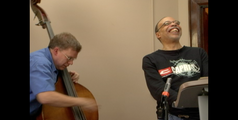Disruptive Dialogics: Improvised Dissonance in Thelonious Monk and Wu-Tang Clan’s 36 Chambers
Paul Watkins
Published: 2011-12-07
My performative paper makes the suggestion that the act of incorporating Jazz samples into Hip Hop music is a type of disruptive performance that interprets a standard musical form to create new styles, producing hybrid genres of music, such as jazz-rap. I examine the sample as a cultural tactic that enacts what Hip Hop scholar Tricia Rose terms as “flow, layering and ruptures in line.” “Layering” is comparable to what we might term in literary studies as intertextuality. DJs layer sounds literally one on top of the other, creating dialogues among samples, sounds, and words; the layers function as dialogue, commentary, percussive rhythms and counterpoint. Julia Kristeva argues that “any text is constructed as a mosaic of quotations; any text is the absorption and transformation of another. The notion of intertextuality replaces intersubjectivity, and poetic language is read as at least double.” In Hip Hop, visual, physical, musical, and lyrical lines are set in motion and broken abruptly with sharp angular breaks, yet they sustain motion and energy through fluidity and flow. The song “Shame on a Nigga” (from 36 Chambers) samples “Black and Tan Fantasy” as performed by Thelonious Monk. Using sampling as a tactical style that denotes improvisation as a disruption (or break) from classical European tradition to posit African American priorities, many of the songs on 36 Chambers participate in polyphonic layering and center around three central concepts outlined in Tricia Rose’s Black Noise: flow, layering, and ruptures in line. Further, the rupturing effect of incorporating a jazz sample into a Hip Hop production compels us to think about how disruption can function as a model for critical practice that relates to the notion of a globally improvised community.
Available Files
-
Monk_and_Clan_s_36_Chambers.pdf
Download


